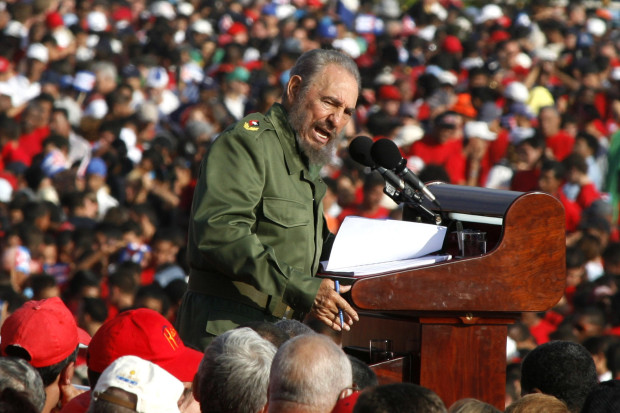HAVANA—Former President Fidel Castro, who led a rebel army to improbable victory in Cuba, embraced Soviet-style communism and defied the power of 10 US presidents during his half-century rule, has died at age 90.
With a shaking voice, his younger brother, Raul Castro, announced on state television that his brother died at 10:29 p.m. on Friday night.
The bearded Castro took power in a 1959 revolution and ruled Cuba for 49 years with a mix of charisma and iron will, creating a one-party state and becoming a central figure in the Cold War.
He was demonized by the United States but admired by many leftists around the world, especially socialist revolutionaries in Latin America and Africa.
Transforming Cuba from a playground for rich Americans into a symbol of resistance to Washington, Castro outlasted nine US presidents in power.
Castro’s reign over the island-nation 90 miles from Florida was marked by the US-backed Bay of Pigs invasion in 1961 and the Cuban Missile Crisis a year later that brought the world to the brink of nuclear war.
Castro, who survived a crippling US trade embargo as well as dozens, possibly hundreds, of assassination plots, died eight years after ill health forced him to formally hand power over to Raul.
Commitment to socialism
Castro overcame imprisonment at the hands of dictator Fulgencio Batista, exile in Mexico and a disastrous start to his rebellion before triumphantly riding into Havana in January 1959 to become, at age 32, the youngest leader in Latin America.
His commitment to socialism was unwavering, though his power finally began to fade in mid-2006 when a gastrointestinal ailment forced him to hand over the presidency to brother Raul in 2008, provisionally at first and then permanently.
“Socialism or death” remained Castro’s rallying cry even as Western-style democracy swept the globe and other communist regimes in China and Vietnam embraced capitalism, leaving this island of 11 million people an economically crippled Marxist curiosity.
US ties
He survived long enough to see Raul negotiate an opening with US President Barack Obama on Dec. 17, 2014, when Washington and Havana announced they would move to restore diplomatic ties for the first time since they were severed in 1961.
He cautiously blessed the historic deal with his lifelong enemy in a letter published after a month-long silence.
Fidel Castro Ruz was born Aug. 13, 1926, in eastern Cuba’s sugar country, where his Spanish immigrant father worked first recruiting labor for US sugar companies and later built up a prosperous plantation of his own.
His life as a rebel began in 1953 with a reckless attack on the Moncada military barracks in the eastern city of Santiago. Most of his comrades were killed and Fidel and his brother Raul went to prison.
Fidel turned his trial defense into a manifesto that he smuggled out of jail, famously declaring, “History will absolve me.”
Freed under a pardon, Castro fled to Mexico and organized a rebel band that returned in 1956. After losing most of his group in a bungled landing, he rallied support in Cuba’s eastern Sierra Maestra mountains.
Three years later, tens of thousands spilled into the streets of Havana to celebrate Batista’s downfall and catch a glimpse of Castro .
Within months, Castro was imposing radical economic reforms.
Members of the old government went before summary courts, and at least 582 were shot by firing squads over two years. Independent newspapers were closed and in the early years, homosexuals were herded into camps for “reeducation.”
In 1964, Castro acknowledged holding 15,000 political prisoners. Hundreds of thousands of Cubans fled, including Castro’s daughter Alina Fernández Revuelta and his younger sister Juana.
Wearing green military fatigues and chomping on cigars for many of his years in power, he was famous for long, fist-pounding speeches filled with blistering rhetoric, often aimed at the United States. He still holds the record for the longest speech before the United Nations at 269 minutes.
At home, he won support for bringing schools and hospitals to the poor, but he also created legions of enemies and critics.
Thrilling defiance
Still, the revolution thrilled millions across Latin America who saw it as an example of how the seemingly arrogant Yankees could be defied.
Many Cubans were also happy to see the seizure of property of the landed class, the expulsion of American gangsters and the closure of their casinos.
As Castro moved into the Soviet bloc, Washington began working to oust him, cutting US purchases of sugar, the island’s economic mainstay. Castro, in turn, confiscated $1 billion in US assets. In 1961, it cut diplomatic ties.
On April 16 of that year, Castro declared his revolution to be socialist, and the next day, about 1,400 Cuban exiles stormed the beach at the Bay of Pigs on Cuba’s south coast, in a failed CIA-backed invasion.
The debacle forced the US to give up on the idea of invading Cuba. But assassination attempts persisted and by Cuban count, he was the target of more than 630 plots. —Reports from the wires


